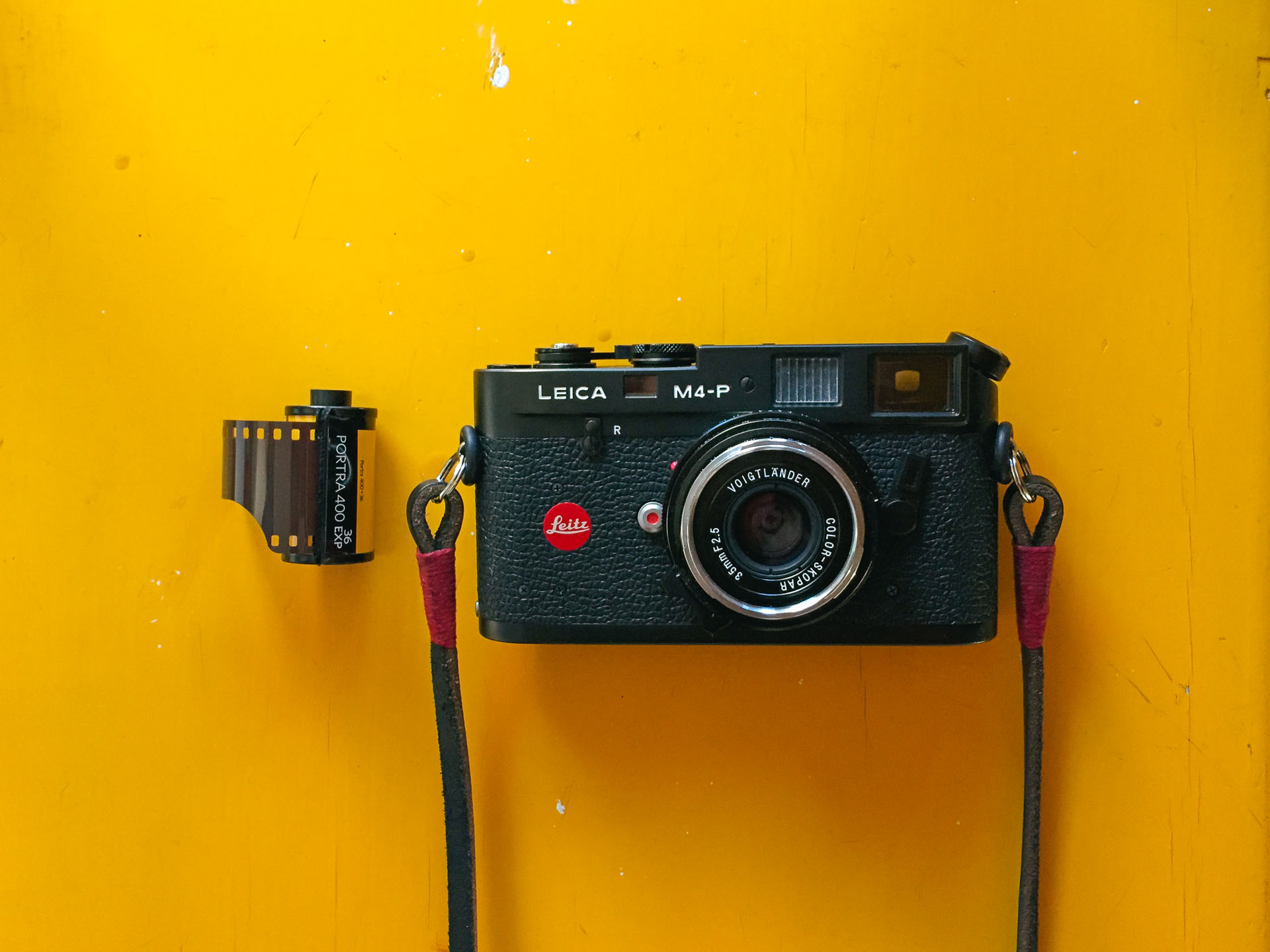A commonly recited criticism towards film Leica’s is that they’re tricky and fiddly to load. After six months of shooting the Leica M4-P I can’t really say I agree. I quickly got used to the loading and after I began trusting in the tulip I find that I actually prefer how it’s loaded compared to most other 35mm cameras.
It did take a few twists and turns before I became fully comfortable with the system though. Since a lot of what’s written elsewhere online approaches the loading from the standpoint of it being tricky, directions tend to describe a very convoluted method for loading. So to counter that I figured I’d make a guide of sorts to the simple approach I use to load my M4-P, as well as recount how I got there. But before getting to that I figured that a bit of background on what makes loading a Leica different is appropriate.
This was originally written as a part of my rolling evaluation of the Leica M4-P, but as I figured this is more general it might be worth having as a separate article.

Leica rangefinders have gone through a few different iterations of how film is loaded, but they’ve all been different to what most people are used to in one significant way. The majority of 35mm film cameras have a rear door that swings open horizontally. This offers full access to the film compartment, shutter gate and take-up spool. It’s easy to see what you’re doing, where the film is going and to understand what’s going on.
Leicas on the other hand, use a removable baseplate for access to the film compartment. The film cartridge and leader need to be pushed together into the camera. Instead of seeing the entire path where the film travels, both the cartridge and take-up spool is covered by the camera body and it’s a bit harder to make out what’s going on.
Earlier models used more crude versions of the design, with removable, clunky, take-up spools, but by the introduction of the Leica M4 in 1966 the system had been refined. The “rapid load system” was designed to streamline the loading and make it as quick as possible. At the heart of it is an odd looking, tulip shaped, take-up spool. Every model introduced since then use the same set-up*.
* For those not keeping track of the models this means the M4, M4–2, M4-P, M5, M6, M7, MP and M-A all use the same way of loading and the method below can be used for all these cameras too.

When I first got the M4-P I took great care loading it. I was weary of losing images after reading accounts of misloaded Leica’s where people had shot for days without noticing that the film wasn’t advancing. As per guides I’ve read I made sure to align the sprockets with the sprocket holes, aligned the film carefully and wound a bit with the back open to make sure everything seemed good.
However when reading the manual it was implied that the baseplate design actually ensured that the film was aligned correctly. Looking into it more I found that the M6 manual goes even further. It says “Don’t be too fussy loading your Leica M6, and don’t waste time trying to align the leader perfectly”. So which is it? Well, in my experience the design is good – you don’t need to fiddle with it and it takes care of even rather sloppy loadings. But it’s also not completely fool proof. There are a few things that you need to be consistent about.
Playing it increasingly fast and loose over half a dozen rolls I did have a problem with one roll. The leader had gotten stuck on the shutter gate and wouldn’t catch on the take-up spool. Since I noticed that the rewind knob wasn’t moving I caught on quickly, but still lost a frame or two. Bothered by the mishap I initially felt like going back to aligning the sprockets et cetera, but soon figured that I just needed to take a small step back and not wing it too much. Since then I’ve not run in to any problems.

So with all that, how’s it actually done?
Well to make it as clear as possible I made a simple video. I describe each step in detail below. Have a look.
This is the way I do it regardless if I’m at home or on the go. I think it might even be a little bit faster when I’m not trying to keep the camera in the video frame and also not having had a bit too much coffee beforehand. Anyway, let’s break it down:
Take the film out of the canister.
It’s easier before you open the camera. If I’m on the go I keep the cartridge palmed in my left hand until I put it in the camera.
Grab the camera and turn it upside down.
I usually hold the camera with my right hand. If I’m on the go I usually have the neck strap around my neck or wrap it around my hand.
Remove the baseplate by turning the latch 180°.
If I’m on the go I keep the baseplate in my right hand between my index and long finger but if I’m at a table I put it down next to the camera. Be mindful about hinging the baseplate on the little pin on the opposite end from the latch.
Let the rear door fall open a little bit.
This isn’t strictly needed, but makes it easier for the film to slide in past the shutter gate and to see what’s going on. I hold it from falling all the way open and flopping around.
Put the film cartridge half way into the camera.
The only slightly fiddly part since you also need to guide the leader into the film track, otherwise it won’t go in.
Slot the leader into the tulip.
This is where the clever take-up spool comes into play. Pull the leader across the width of the camera and slot it into the prongs of the tulip-shaped take-up spool. Do it like on the diagram on the camera but don’t be fussy with the length or exact alignment. The tulip will take care of it.
Push the cartridge and leader into the camera.
I use the thumb for the cartridge and index finger for the leader and give both a gentle push so they seat properly.
Take a quick look through the rear door.
Check that the film is clear of the shutter gate and looks ok. Keep an eye out for the film being crinkled or caught somewhere. Don’t worry if it’s not perfectly straight or correctly aligned, the baseplate and rear door takes care of this for you.
Replace the baseplate.
Push the rear door shut and put the baseplate back the opposite way than when previously removing it.
Wind and release the shutter – and you’re done!
Keep an eye on the rewind crank, if it rotates like in the video you can be sure you’ve loaded correctly. If it doesn’t double-check with the step below. Don’t be too careful when winding on since that supposedly makes it likelier for the leader to slip. I generally only wind on once while loading. Sometimes the first frame has been exposed to too much light already and can’t be used. But if I load in a dim or dark room even this first frame usually turns out ok and I’ve even gotten 39 frames on a 36 roll with this method. If I load in bright conditions or if I want to be safe I wind on twice, consistently giving me 38 good frames in a roll.
Rewind any slack.
This part isn’t in the video as I’d already seen the rewind crank turn. I then generally wait a few frames before doing this step. Because there’s varying amounts of tension in film canisters it’s a good idea to remove any slack. This makes sure film is transported evenly through the camera. But the main reason is to ensure that the film is loaded correctly. Fold open the rewind crank and turn it a bit in the direction the arrow shows. If there’s little resistance and if it decreases you might’ve misloaded. If there’s a bit of resistance that also increases, keep going until the resistance becomes stiff and then stop. Don’t force it. You now know the film is properly loaded and winding on the next few times will also turn the rewind crank, another proof of proper film transport.

That's it – it takes far longer to read than to do, but loading is done and you can go out and shoot. But just to reiterate, there are a few steps recommended elsewhere that are unnecessary in my experience:
The steps that would’ve caught my single misload is to push the film in enough and have a quick look that it hasn’t crinkled.
That’s pretty much it for my experiences loading the Leica M4-P. Once again something about Leicas that had previously felt a bit odd and almost mysterious to me turned out to be pretty straightforward and more enjoyable than I’d thought.
I hope this guide can be useful for others too. Let me know your experiences over on Twitter.
All photos in this post were taken using the Leica M4-P except for images of the camera and the video, shot on an iPhone 6. Exif-data is intact. Open any image in a new window for a closer look.